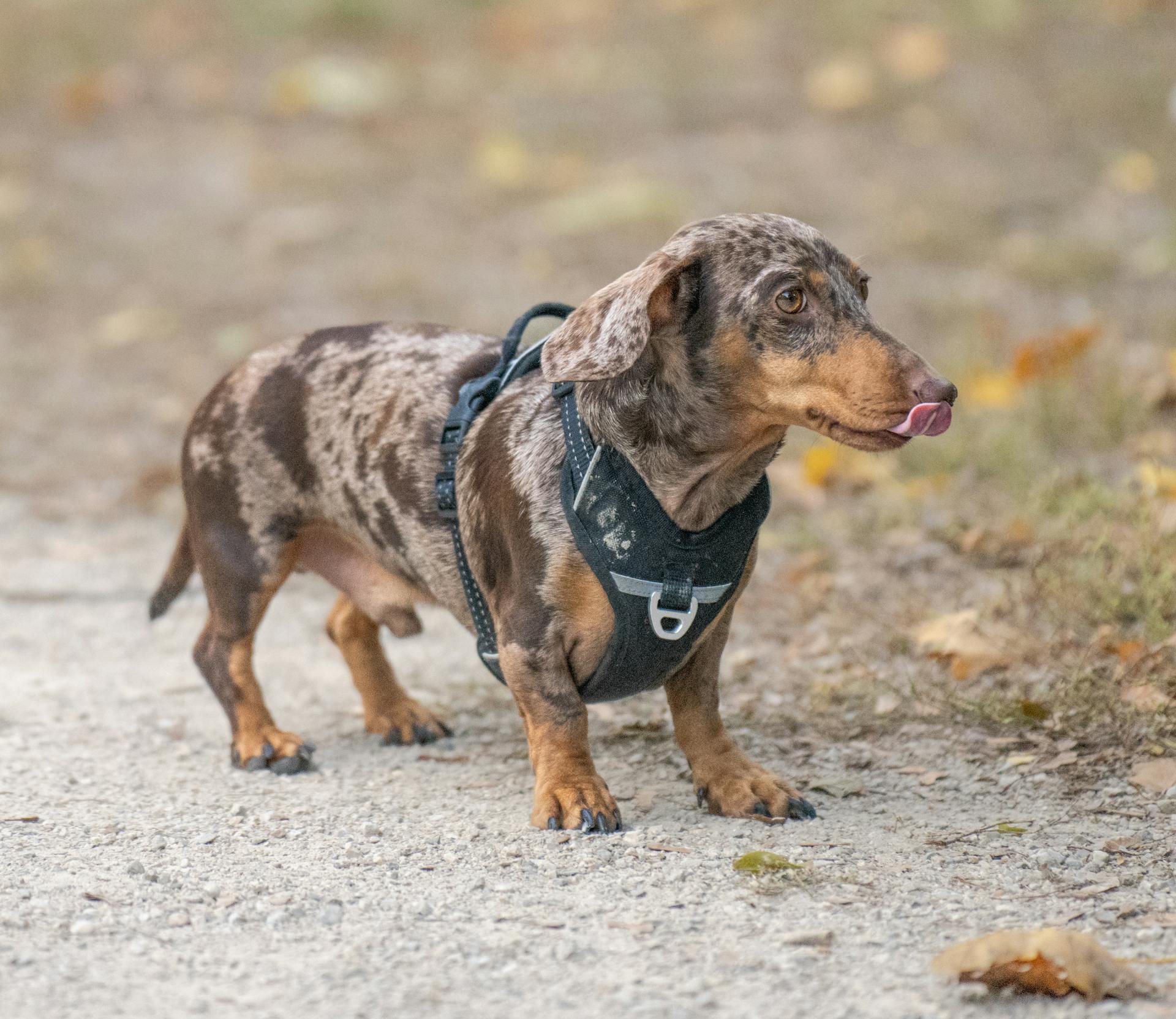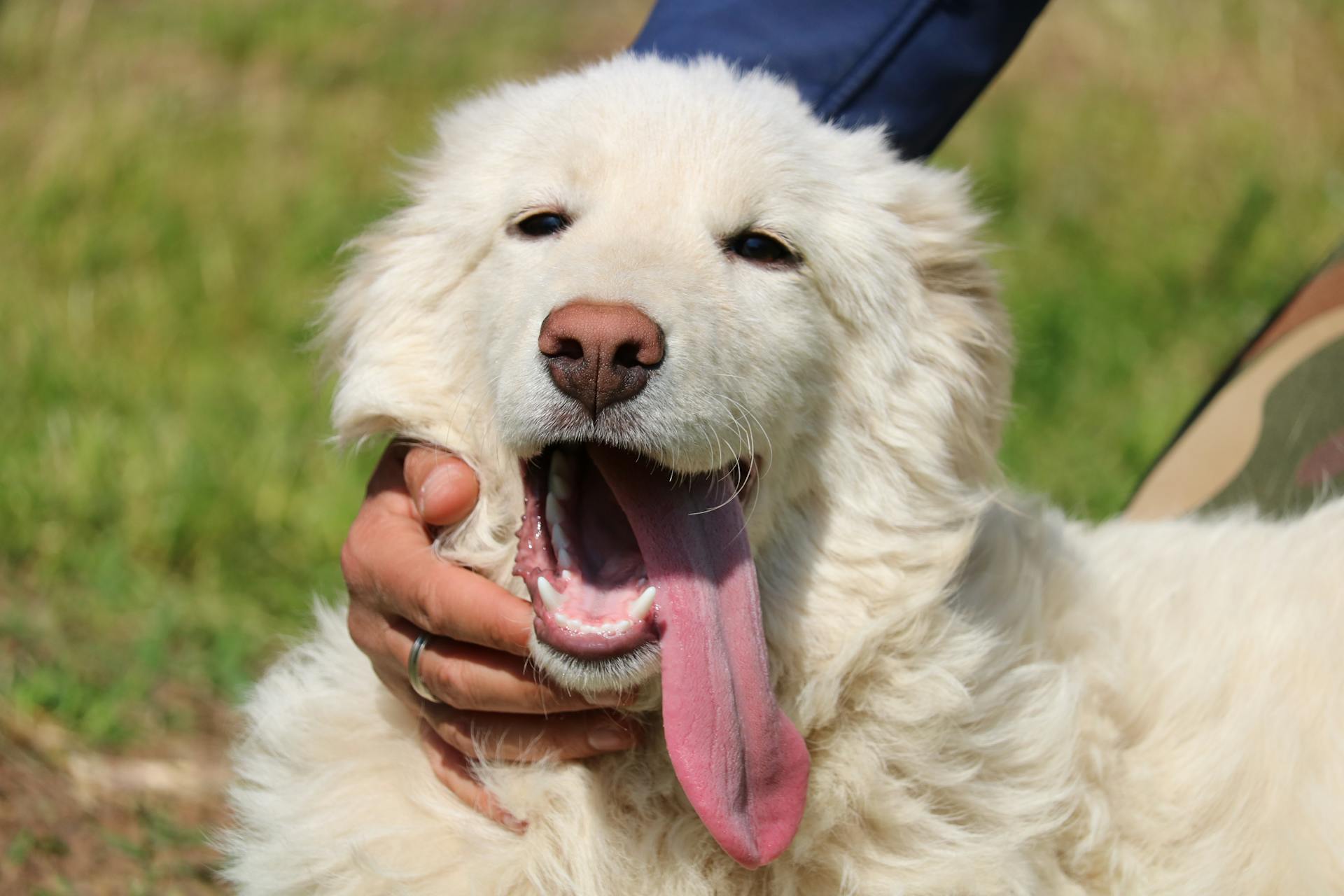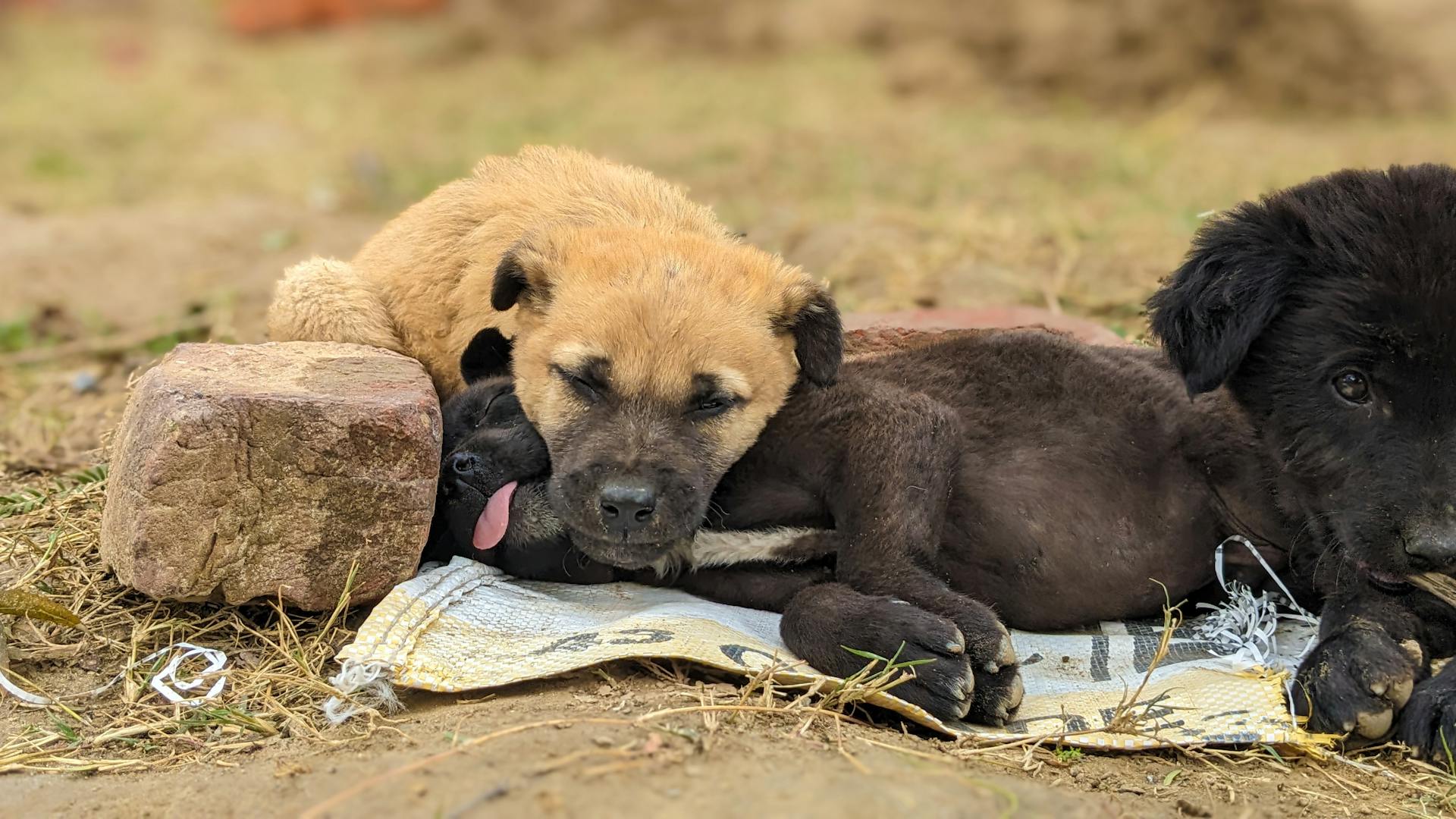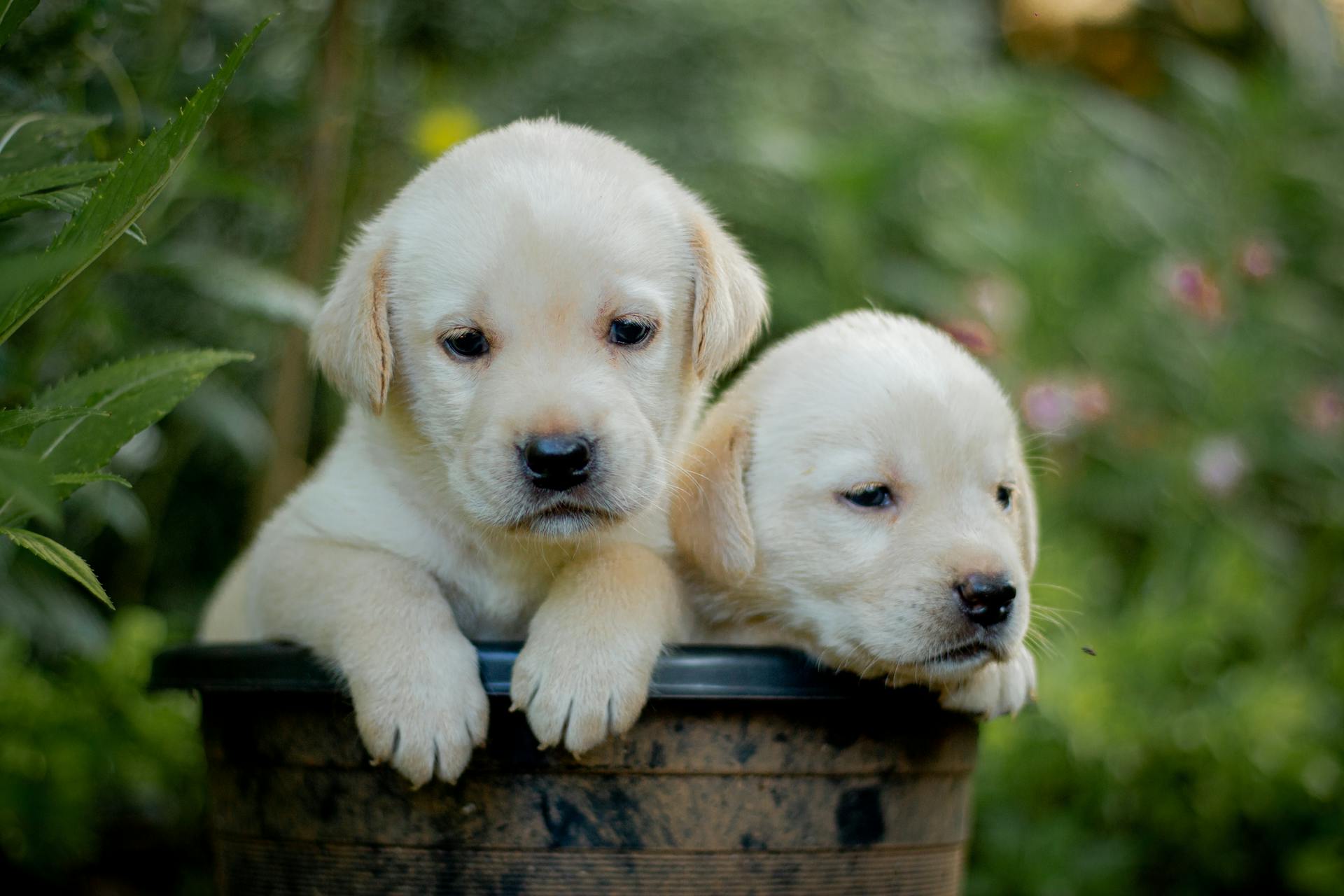
So, you're thinking of bringing home a Puggle Mix? Congratulations! This adorable crossbreed is a bundle of energy and joy, but it does require some special care.
Puggle Mixes typically weigh between 15-30 pounds and stand about 13-17 inches tall, making them a great size for apartment living or families with small yards.
To keep your Puggle Mix happy and healthy, regular exercise is a must. Aim for at least 30 minutes of playtime or walks per day, and consider adding some fun activities like agility training or fetch.
The Puggle Mix's short coat sheds minimally, but it does require regular brushing to prevent matting and tangling.
Pet Care
Puggles are social animals and need plenty of attention and interaction. They thrive on companionship and can get lonely if left alone for too long.
To keep your puggle happy and healthy, you'll need to brush their coat at least once a week. This will help remove loose hair and prevent matting.
In addition to regular brushing, you'll also need to clean your puggle's wrinkles daily. Use pet wipes, baby wipes, or a damp cotton ball to gently wipe away dirt and debris.
Puggles are active dogs and need plenty of exercise to stay happy and healthy. Aim for at least an hour of physical and mental stimulation every day, which can include walks, jogs, hiking, and playtime with other dogs.
Training a puggle can be a bit challenging, especially if they inherit a mischievous streak from their pug parent. Patient, positive reinforcement training is key, and treats can be a great motivator.
Here are some things to consider when training your puggle:
- Use treats as rewards to encourage good behavior
- Be patient and consistent in your training
- Provide plenty of praise and affection to reinforce good behavior
Remember, puggles can be prone to obesity if they don't get enough exercise, so be sure to track their calories and provide a balanced diet to keep them at a healthy weight.
Health
Puggles are generally a healthy breed, but they can inherit health problems from their parent breeds. They can be prone to respiratory issues, such as difficulty breathing, wheezing, and noisy breathing, especially if they have a flat face.
Puggles can also be susceptible to heatstroke, so it's essential to provide them with plenty of water, cool places to rest, and shade when they're outdoors in hot weather. Regular check-ups with a vet can help identify any potential health issues early on.
Some common health problems that can affect Puggles include patellar luxation (slip knee), hip dysplasia, and eye conditions. Regular exercise and a balanced diet can help prevent obesity, which is another common issue in Puggles.
Health Issues
Puggles can inherit health problems from their parent breeds, including seizures, walking in circles, lack of coordination, abnormal gait, and blindness. It's essential to find a reputable breeder who prioritizes health over profit and tests for these conditions.
Puggles are generally a healthy breed, but they can still suffer from respiratory issues, such as difficulty breathing, wheezing, and noisy breathing, especially if they have a flat face. This is because their longer snout, inherited from the Beagle, isn't guaranteed, and they can still be prone to these problems.
You might enjoy: Puggle Problems Health
Puggles are also susceptible to heatstroke, so it's crucial to provide them with plenty of water, cool places to rest, and shade when they're outdoors in hot weather. Regular exercise and a balanced diet can also help prevent health issues.
Some common health issues in Puggles include pinched nostrils, cherry eye, and ear infections. Regular ear checks and veterinary care can help prevent these problems. Hip dysplasia and epilepsy are also potential health concerns in Puggles.
Here are some potential health issues in Puggles, along with their parent breeds:
- Seizures (Pug and Beagle)
- Walking in circles (Pug and Beagle)
- Lack of coordination (Pug and Beagle)
- Abnormal gait (Pug and Beagle)
- Blindness (Pug and Beagle)
- Difficulty breathing, wheezing, and noisy breathing (Pug)
- Heatstroke (Pug)
- Pinched nostrils (Pug and Beagle)
- Cherry eye (Pug and Beagle)
- Ear infections (Pug and Beagle)
- Hip dysplasia (Pug and Beagle)
- Epilepsy (Pug and Beagle)
Lifespan
A Puggle's lifespan is a significant aspect of their overall health. A Puggle has a typical life expectancy of anywhere between 11 to 15 years.
To ensure your Puggle lives a long and healthy life, regular veterinary check-ups are essential.
Nutrition
Puggle mixes, like any other breed, require a balanced diet to stay healthy. A puggle's nutritional needs depend on its age, size, and activity level.
For a baby puggle, the daily calorie intake is different from an adult's. Male puppies need 1,400 calories a day, while females require 1,100 calories. For adult puggles, males need 700 calories daily, while females need 500 calories.
Puggles love to eat, and it's essential to avoid overfeeding them to prevent obesity. You can divide the daily calorie count into two meals to determine the correct amount of food to serve. For example, if your adult puggle needs 700 calories, you can divide that by two to determine the correct amount of food to serve at each meal.
Check this out: Awana Puggles
Nutrition
Puggles have different dietary needs depending on their age, size, and activity level. As a general rule, you should consult with your veterinarian to develop a feeding plan that's tailored to your pup's unique needs.
For baby puggles, the calorie count is higher than for adult puggles. Male puppies need 1,400 calories a day, while females need 1,100 calories.
Readers also liked: What Breed Is a Puggle
To avoid overeating, it's best to stick to a balanced and nutritionally complete dog food. Avoid giving your puggle human food, as it can lead to cravings and refusal to eat their regular food.
Puggles love to eat, and they can easily become overweight or obese if not monitored. Even if they're not active, they'll still munch on food throughout the day.
As a pet owner, exercising restraint when your puggle stares at you for food is crucial. It's also essential to consider treats as part of your puggle's daily calorie intake.
For adult puggles, a general feeding guideline is to serve one cup of dog food each, divided into two meals in the morning and evening. However, this may vary depending on your veterinarian's recommendation.
Puggles are prone to weight gain, so it's essential to work with your veterinarian to determine the right amount of food for your puggle. They'll consider factors like weight, body condition score, lifestyle, and health needs.
You can find a recommended daily feeding guide on the nutrition label of your dog food bag, but this is just a general idea. It's always best to consult with your veterinarian for a personalized feeding plan.
See what others are reading: Bully Mix Dog
Nutrition
As a puggle owner, you'll want to make sure your furry friend is getting the right nutrients to stay healthy and happy. Puggles are prone to obesity due to their huge appetite, so it's essential to keep an eye on their food intake.
Their short, fine coat requires regular grooming, but it's also relatively low-maintenance compared to other breeds. A puggle's diet should include high-quality food that meets their nutritional needs, with a focus on protein, fat, and carbohydrates.
Puggles are active dogs, but they don't require as much exercise as some other breeds. A daily walk and playtime should suffice, but be sure to monitor their food intake to prevent overeating.
Here are some general guidelines for feeding your puggle:
Remember, every puggle is different, and their nutritional needs may vary depending on their size, age, and activity level. Consult with your veterinarian to determine the best diet for your furry friend.
Behavior and Training
Puggles are very trainable, especially when treats are involved. They thrive on positive reinforcement and consistent training.
Because Puggles are social creatures, they need companionship and physical and mental enrichment each day. They can become bored and lonely if left alone for long periods, leading to unwanted behaviors like excessive barking, chewing, and house soiling.
Puggles are intelligent dogs, making them fairly easy to train. However, they require patience, persistence, and consistency. Positive reinforcement training is the best way to teach your Puggle while building the human-animal bond.
Here are the 4 P's that can help make training easier:
- Patience – it will help you understand your dog and keep your cool when they don't pick up as fast as you expect.
- Persistence and Consistency – these two things should go hand-in-hand to ensure your dog learns new behaviors.
- Positive Reinforcement – use rewards like treats, praise, and playtime to reinforce good behavior.
- Playmates – socialization is key to developing social skills and intelligence in your Puggle.
Puggles are naturally curious and love to follow their nose, so it's essential to help them explore safely. Always keep your Puggle on a leash or within a securely fenced area.
Puggles are affectionate and playful dogs that thrive in homes with a lot of attention and activity. They love children and adults alike, making them the perfect family dog. However, they can be stubborn and hot-tempered if their wants are not met, so be sure to provide plenty of attention and affection.
Lifestyle
Puggles are active dogs who need a lot of attention, so they're perfect for families with small children. They thrive on interaction and will keep kids entertained for hours.
To keep your Puggle happy and healthy, you'll need to provide regular exercise, which can be as simple as leashed walks or fetch in a fenced-in yard. They also love to play hide-and-seek with toys and go on moderate jogs and easy hikes.
A Puggle's energy level can be a challenge, but with dedication, you can keep them mentally stimulated and prevent undesirable behaviors like digging and barking.
Daily Life
Daily life with a Puggle is a joy, but it does require some effort to keep them happy and healthy. They need regular exercise to burn off their excess energy, which can be a challenge if you live in an apartment without a yard.
A Puggle will be very happy in a home with a fenced-in yard, but be prepared for some digging and barking. They can also thrive in apartments with an owner who's dedicated to giving them regular, thorough exercise.
To prevent boredom and undesirable behaviors, you should let your Puggle get out their energy in a way that's fun for both of you. This can be as simple as a leashed walk or a game of fetch.
Here are some fun activities you can do with your Puggle:
- Leashed walks
- Fetch
- Nose work
- Hide-and-seek with toys
- Obedience training
- Skills training
Puggles aren't very happy being left alone for long stretches of time, so you may need to make arrangements for doggy daycare or a dog walker. But with their sociable and sweet nature, they're perfect companions for small children, who can provide them with the attention and exercise they need.
Where to Buy a Dog
If you're looking to bring a new furry friend home, it's essential to do your research on where to buy a dog. You can start by searching online for a reputable breeder in your area, as this will give you a chance to see if they're a good fit for you and your family.
Always prioritize buying from a reputable breeder, as this will ensure the health and well-being of the dog. Just because one breeder charges a higher price, it doesn't necessarily mean they're better dogs.
Buying from a reputable breeder is worth the extra effort, as it will give you peace of mind knowing your new pet is coming from a trustworthy source. This is especially important when it comes to meeting with the breeder in person to see how they're caring for the dogs.
For more insights, see: Boxer Mix Breed
Care and Maintenance
Puggles are relatively low maintenance when it comes to grooming, but they do shed seasonally and require regular brushing to remove loose hair.
You should brush your puggle at least once a week with a medium bristle brush or a rubber grooming mitt to keep their coat looking its best. This will also help prevent matting and skin conditions.
Puggles also need their wrinkles cleaned daily, especially if they're particularly wrinkly. Use pet wipes, baby wipes, or a damp cotton ball to gently clean their wrinkles and keep them healthy.
In addition to grooming, puggles need plenty of exercise to stay happy and healthy. Aim for at least an hour of exercise per day, which can include walks, jogs, hiking, and playtime with other dogs.
To keep your puggle at a healthy weight, you'll need to track their calories and ensure they're getting enough physical and mental stimulation. This will also help prevent obesity, which is a common issue in both pugs and beagles.
Here are some key grooming tasks to include in your puggle's weekly routine:
- Brush their coat at least once a week
- Clean their wrinkles daily
- Bathe them every few months
- Trim their nails regularly
- Brush their teeth regularly
- Check their ears for infection and clean them as needed
- Check their eyes for dirt or discharge and clean them as needed
Remember, every puggle is different, so be patient and adjust your grooming and exercise routine accordingly. With the right care and attention, your puggle will thrive and become a beloved member of your family.
History and Origin
The Puggle mix has a fascinating history. They were first bred in the 1990s by Wallace Havens from Wisconsin.
The mother of a Puggle must always be a Beagle, and the father a Pug, due to known complications that arise when a larger male mates with a smaller female dog.
Wallace Havens was the first to officially breed Puggles, and his goal was to create a fun-loving dog with a Beagle's snout and intelligence.
Puggles were not the result of cross-breeding in the 19th century, but rather they "officially" existed in the 1990s.
By cross-breeding a Pug and a Beagle, Havens aimed to remove the complications that can arise with a Pug's snout, while keeping their loving nature.
Pugs are prone to several health issues, including Pug Dog Encephalitis, stenotic nares, keratoconjunctivitis sicca, and obesity.
A fresh viewpoint: Chiweenie Pug Mix
Compatibility and Safety
A family home with children is the perfect place for a Puggle, as they love playtime and will want to join in with things.
Puggles are active dogs who need a lot of attention, so small children are the perfect people to have around these pups.
You will want to make sure they are socialized from a young age, as this will help them get along with the kids.
With proper training, Puggles are not going to cause children any harm, thanks to their sociable and sweet nature.
They will want to curl up on the couch with you for a cuddle at the end of a long day, so be prepared for some snuggle time.
Owning a Dog
Owning a Puggle mix can be a wonderful experience, but it's essential to understand their needs and characteristics. Puggles are active dogs who require a lot of attention, making them perfect for families with small children.
Their sociable and sweet nature ensures they won't cause harm to kids, but it's crucial to train them properly to ensure a harmonious household. Puggles are generally small, weighing between 14-30 pounds, but they're far from lazy.
They need close companionship and plenty of activity to thrive, which means you'll need to provide them with regular exercise and mental stimulation. Puggles often resemble larger Pugs, but with longer ears, muzzles, and legs, and a Beagle-like tail.
They're affectionate and outgoing family dogs who love to be around their pack, so be prepared to spend quality time with your Puggle mix. With proper training and care, your Puggle mix can become a loving and loyal companion.
General Information
The puggle mix is a delightful companion for active families. They're small in size, standing between 10 to 15 inches tall and weighing 14 to 30 pounds.
Puggles have a medium energy level, which means they need regular exercise to stay happy and healthy. They're not suited for a sedentary lifestyle, so if you're looking for a couch potato, a puggle might not be the best fit.
Their lifespan is relatively long, ranging from 10 to 15 years, which is a significant commitment for any pet owner. However, the rewards of owning a puggle far outweigh the responsibilities.
Puggles are friendly, outgoing, and playful, making them a great addition to families with children. They're also good with other dogs, which is a bonus for dog owners who want to socialize their pets.
Here are some key characteristics of the puggle mix:
Frequently Asked Questions
What is a Puggle a mix of?
A Puggle is a cross between a Beagle and a Pug, making it a unique hybrid dog breed. This mix of two popular breeds creates a one-of-a-kind companion.
Do Puggle dogs bark a lot?
Puggles are prone to barking, especially at strangers, but their friendly nature makes them more likely to alert than aggressively defend. They can make good watchdogs due to their tendency to bark, but not guard dogs.
How big will a Beagle Pug mix get?
A Beagle Pug mix, also known as a Puggle, typically weighs between 14-30 pounds. They are a lively and energetic breed, requiring regular exercise and attention.
Do Pug Beagle mix shed?
Yes, Pug Beagle mixes shed heavily, requiring regular brushing to manage their coat. Expect to find a significant amount of fur around your home each week.
Featured Images: pexels.com


